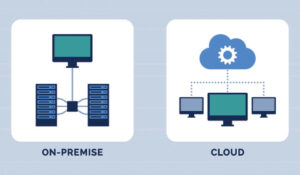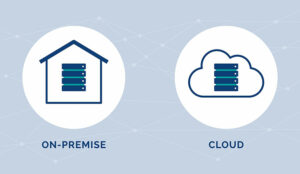Calabrio breaks down the complexities of cloud vs. premise-based contact centre solutions, providing clarity to help you build a future-proof strategy for contact centre and CX success.
In today’s hyper-competitive landscape, delivering exceptional customer experiences is no longer a luxury, it’s a lifeline.
In light of this, the contact centre is increasingly recognized as the epicenter of customer interaction and brand perception.
And while much attention is rightfully paid on contact centre management strategies and questions of how to maximize employee engagement and agent performance, decisions around call centre infrastructure remain key to keeping up with fast-evolving innovations and customer demands.
The choice between an on-premise vs. cloud contact centre is a pivotal one, influencing everything from operational efficiency and cost to scalability and the ability to innovate.
Despite the huge growth in cloud models in recent years, many organizations still rely on-premise-based and hybrid approaches.
According to the State of the Contact Centre 2025 report, 31% of CX leaders said they rely on an on-premise contact centre platform-and 35% said the same of their workforce management and quality assurance tools.
While the “best” option can depend on unique business circumstances, understanding the fundamental differences, benefits, and drawbacks of each is paramount.
Understanding the Fundamentals: Defining On-Premise and Cloud Contact Centres
Before diving into a direct comparison, let’s establish a clear picture of each type of contact centre.
What is An On-Premise Contact Centre?
An on-premise contact centre is a traditional model where an organization hosts and maintains all the related hardware and software infrastructure within its own physical facilities or data centres.
This means the company purchases the servers, private branch exchange (PBX) systems, desktop hardware, and software licenses. An internal IT team is typically responsible for installation, ongoing maintenance, upgrades, and security.
These on-premise call centre solutions offer a high degree of control over the entire environment, as all components are owned and managed in-house.
However, as we’ll explore, among other drawbacks, traditional call centre infrastructure typically involves significant upfront investment in physical assets.
What is a Cloud Contact Centre?
A cloud contact centre, typically built upon the foundation of a Cloud Contact Centre as a Service (CCaaS) platform, represents a modern approach where the contact centre technology and infrastructure are hosted on the provider’s servers and accessed by the business via the internet.
Instead of purchasing and maintaining hardware and software, organizations typically pay a subscription fee.
In this model, the CCaaS provider is responsible for managing the core infrastructure, software updates, security, and ensuring uptime.
Cloud-based contact centre solutions – which, beyond the CCaaS itself, also include CRM platforms, WEM solutions, and other critical contact centre tools – shift the burden of call centre infrastructure management to the vendor, allowing businesses to access advanced capabilities without the heavy lifting of direct ownership.
This model allows for greater flexibility, particularly in our age of increased remote and hybrid work, as agents can typically access the platform from anywhere with an internet connection.
The Core Comparison: Cloud vs. On-Premise Contact Centre
The decision between on-premise and cloud solutions impacts nearly every facet of a contact centre’s operation. Here’s a detailed comparison across key criteria:
Cost & Total Cost of Ownership (TCO):
On-Premise
This model is characterized by high upfront capital expenditure (CapEx). Businesses must invest heavily in servers, networking equipment, software licenses, and often, dedicated physical space.
Ongoing costs include IT staff for maintenance, troubleshooting, upgrades, electricity, and cooling. While proponents might argue for lower long-term costs if the system is maintained efficiently for many years without major upgrades, this scenario is increasingly rare given the pace of technological change.
The Total Cost of Ownership (TCO) can often be higher than anticipated due to unforeseen upgrade cycles and maintenance demands.
Cloud
Cloud contact centers significantly lower upfront costs, replacing large CapEx with more predictable operational expenditure (OpEx) through a subscription model.
The provider handles all infrastructure maintenance, software updates, and often, the IT expertise, reducing the internal burden.
This model typically offers the potential for better – and faster – ROI, as businesses pay only for the resources they use and can more easily scale according to their needs.
The cost savings cloud contact centre solutions offer become particularly evident when factoring in reduced IT overhead and the avoidance of expensive hardware refreshes.
Scalability & Flexibility:
On-Premise
Scalability is a significant challenge for on-premise contact centre solutions. To scale up, organizations must purchase, install, and configure new hardware and software licenses, a process that can be slow and costly.
Scaling down often means underutilized, expensive hardware. Businesses frequently over-provision resources to handle peak loads, leading to inefficiencies during average or slow periods.
Cloud
Cloud-based contact centre solutions offer unparalleled scalability cloud contact centre agility. Businesses can easily add or remove agent seats, communication channels, and features almost instantaneously, often through a simple administrative portal.
This elasticity allows companies to respond rapidly to changing business needs, seasonal peaks, or unexpected events, paying only for the capacity required at any given time.
Deployment Speed & Implementation:
On-Premise
Deploying an on-premise system is often a lengthy process, potentially taking weeks or even months. This includes hardware procurement, installation, software configuration, integration with existing systems, and thorough testing.
Cloud
Cloud contact centres boast more rapid deployment times, often getting new solutions up and running within days or hours – helping teams focus on onboarding, adoption, and optimization even sooner. Since the core infrastructure is already in place and managed by the provider, setup primarily involves configuring the software to meet specific business requirements and training users.
Technology & Innovation (Including AI):
On-Premise
Accessing new features, functionalities, and cutting-edge technologies like AI in an on-premise environment often requires significant, costly upgrades or new module purchases.
The innovation cycle is generally slower, and integrating advanced tools can be complex and resource-intensive.
Cloud
Cloud providers continuously update their platforms and more seamlessly offer automatic access to the latest features and innovations, including advancements in AI in contact centers, machine learning, and advanced analytics.
CCaaS and WFO vendors invest heavily in research and development, working to ensure that their solutions help customers’ contact centres stay ahead.
Reliability & Business Continuity:
On-Premise
Reliability is contingent upon the organization’s internal infrastructure, power supply, and disaster recovery capabilities.
Local events like power outages, hardware failures, or natural disasters can lead to significant downtime unless robust (and often expensive) internal redundancy and disaster recovery plans are in place.
Cloud
Reputable solutions providers typically offer high uptime Service Level Agreements, often 99.9% or even 99.99%.
They achieve this through geo-redundancy, with data and operations distributed across multiple secure data centres. This means if one location experiences an issue, traffic can be automatically rerouted, ensuring business continuity.
Security & Compliance:
On-Premise
On-premise solutions offer organizations complete control over their data and security protocols. This can be advantageous for businesses with highly specific or niche compliance requirements.
However, the entire burden of maintaining state-of-the-art security, including patching, threat detection, and adherence to evolving compliance mandates (like GDPR, HIPAA, PCI-DSS), rests solely on the organization’s internal IT team. A lapse in diligence can lead to significant security risks and data breaches.
Cloud
Leading cloud providers invest massively in security infrastructure and expertise, often exceeding what individual companies can afford. They typically adhere to a wide array of international and industry-specific compliance standards.
Security in the cloud operates on a shared responsibility model: the provider secures the infrastructure, and the customer manages user access and data within the application.
While initial concerns about cloud security were common, modern cloud platforms offer robust, multi-layered security.
Remote Work & Geographic Flexibility:
On-Premise
Supporting a remote workforce with on-premise systems can be cumbersome and less secure. It often necessitates complex VPN setups and can present challenges in terms of call quality and system access for agents working outside the central office.
Cloud
Cloud contact centres are inherently designed to support remote and geographically distributed workforces.
Agents can typically log in and access all necessary tools from anywhere with a stable internet connection and a web browser. This not only facilitates work-from-home models but also allows businesses to tap into a global talent pool.
IT Management & Maintenance:
On-Premise
On-premise call centre solutions demand significant and ongoing attention from an internal IT department.
This includes managing servers, databases, software updates, patches, troubleshooting issues, and planning for upgrades. These responsibilities can divert valuable IT resources from other strategic business initiatives.
Cloud
With cloud-based contact centre solutions, the provider handles all infrastructure maintenance, updates, and technical support for the core platform.
This dramatically reduces the burden on internal IT teams, freeing them to focus on other value-added projects rather than routine system upkeep.
Deep Dive: The Overwhelming Benefits of Cloud Contact Centres
The comparison above begins to illustrate why cloud solutions are gaining prominence. Let’s delve deeper into the specific benefits of cloud contact centre deployments that drive significant business value:
Improved Agent Experience & Productivity
Modern, intuitive user interfaces are a hallmark of many cloud-based platforms and solutions. Agents benefit from unified desktops and dashboards that bring together all necessary tools and customer information in one place.
Advanced Analytics & Reporting
One of the most powerful benefits of cloud-based solutions is access to sophisticated interaction analytics and real-time reporting.
These platforms can capture vast amounts of data on call volumes, handling times, agent performance, customer sentiment, and interaction trends.
This data provides actionable insights for optimizing operations, improving training, and making informed, data-driven decisions.
Seamless Integrations
Cloud contact center platforms are generally designed with open APIs and pre-built connectors, making it easier to integrate them with other critical business systems such as CRM software, CX analytics, Workforce and Quality Management solutions, ERP and HR systems, helpdesk software, and business intelligence tools. This creates a more unified tech ecosystem and breaks down data silos.
Future-Proofing Your Operations
The business landscape and customer expectations are constantly evolving. Cloud solutions are inherently more adaptable.
Providers continuously update their platforms with the latest technologies and features, ensuring that your contact centre can keep pace with change without requiring massive reinvestments or complex overhauls.
Focus on Core Business
By offloading the complexities of managing call centre infrastructure to a specialized provider, businesses can redirect their internal resources, both financial and human, towards their core competencies and strategic objectives, rather than getting bogged down in IT management.
Meeting Skyrocketing Customer Expectations: The (Cloud) Omnichannel Imperative
It’s nearly impossible to overstate the importance of the cloud-driven benefits we’ve described above. However, there’s one more advantage of cloud-based solutions that demands some extra emphasis: their outsized potential impact on customer experience quality.
Today’s customers demand more than just quick answers; they expect seamless, personalized, and consistent interactions across every touchpoint.
However, delivering on this is remains a significant challenge. The State of the Contact Centre 2025 survey starkly illustrates this gap, finding that just 36% of contact centres provide a truly omnichannel contact centre experience. This is despite the long-term, marked rise in demand for such service.
The pressure is mounting, as research has indicated that 90% of customers expect their interactions to be consistent across all channels.
They anticipate that information shared in a chat will be available to an agent on a subsequent phone call, and that promotions seen on social media will be honoured on the company website.
When these expectations aren’t met, when customers have to repeat themselves or encounter disjointed experiences, frustration rises and loyalty erodes.
Cloud-based contact centre solutions and infrastructure are fundamentally better equipped to address this omnichannel imperative.
Their inherent flexibility, integration capabilities, and centralized data management allow businesses to unify customer interactions across an expanding array of channels from voice and email to chat, social media, and SMS.
This provides agents and leaders both with a holistic view of the customer journey, empowering them to deliver the consistent, contextual, and personalized service that modern consumers not only prefer but outright demand.
Addressing the Challenges of On-Premise Contact Centre Solutions
While the momentum is clearly towards the cloud, it’s important to acknowledge why some organizations may still operate on-premise contact centre solutions.
Often, this is due to significant investments in legacy systems, specific data governance policies that mandate local data storage, or a perceived need for absolute control over every aspect of the infrastructure.
However, these on-premise call centre solutions come with inherent and growing challenges of on-premise contact centres:
- High Upfront and Ongoing Costs: Beyond the initial capital outlay, the costs of maintaining, upgrading, and staffing an on-premise system can be substantial and unpredictable.
- Lack of Flexibility and Agility: The inability to quickly scale resources up or down in response to changing business needs is a major handicap in today’s dynamic market.
- Slower Innovation Cycles: Keeping pace with technological advancements, especially in areas like AI and omnichannel support, is difficult and expensive with on-premise systems.
- Significant Maintenance Burden: The responsibility for all updates, patches, and troubleshooting falls on the internal IT team, diverting them from other strategic work.
- Difficulty Supporting Remote and Hybrid Work Models: Enabling a distributed workforce efficiently and securely is often complex and costly with traditional on-premise infrastructure.
- Risk of Technological Obsolescence: Hardware and software can quickly become outdated, requiring expensive “rip and replace” upgrades to maintain competitiveness.
These challenges highlight the increasing limitations of premise-based solutions in an era that demands speed, flexibility, and continuous innovation in customer engagement, and which are precisely the pain points that modern cloud solutions are designed to alleviate.
Making the Switch: Migrating from On-Premise to the Cloud
Whether you’re already using a cloud-based CCaaS and want to integrate leading CX management solutions in the cloud, or you need to upgrade your legacy on-prem infrastructure wholesale, cloud adoption and migration can seem like a daunting prospect.
However, with careful planning and the right partner, the transition can be smooth and lead to significant long-term advantages.
Key considerations for a successful transition to, or expansion within, the cloud include:
Thorough Assessment
Begin by evaluating your current contact centre’s strengths and weaknesses, infrastructure, processes, and existing technology. Clearly define your future needs, business goals, and desired CX outcomes.
Choosing the Right Provider and Solution
Not all cloud-based contact centre solutions are created equal. Research providers based on their reliability, security, feature set, scalability, integration capabilities, support, and industry expertise.
Look for solutions that align with your specific requirements, and come from providers with robust technical support services to help ensure a seamless transition.
Developing a Data Migration Strategy
Plan how you will migrate existing customer data, call recordings, and other relevant information to the new cloud platform securely and efficiently.
Integration Planning
Identify all necessary integrations with existing business systems like CRM, helpdesk, and workforce optimization tools. Ensure the chosen cloud solution offers robust API support or pre-built connectors.
Change Management and Training
Prepare your team for the transition. Communicate the benefits of the new system and provide comprehensive training to ensure agents, supervisors, and administrators are comfortable and proficient with the cloud platform.
Phased Rollout
For larger or more complex operations, consider a phased rollout, migrating teams or functionalities incrementally to minimize disruption and allow for adjustments along the way.
While the process requires legwork and long-term commitment, the benefits of increased flexibility, reduced IT burden, access to innovation, and improved customer and agent experiences typically far outweigh the short-term transition challenges.
Many businesses find that a hybrid approach, at least initially, can also be a viable stepping stone, allowing them to leverage cloud capabilities for specific functions while gradually phasing out on-premise components.
The Future is in the Cloud: Trends Shaping Contact Center Solutions
The contact centre landscape is in a perpetual state of evolution, driven by technological advancements and shifting customer expectations. Cloud platforms are uniquely positioned to embrace and enable these future trends:
Deeper AI and Automation Integration
Artificial Intelligence will become even more integral. Expect more sophisticated AI-powered chatbots and virtual agents handling complex queries, GenAI-driven tools for anticipating customer needs and agent guidance, and automation of routine tasks to free up human agents for high-value interactions. The future of contact centre solutions is undeniably tied to AI.
Hyper-Personalization at Scale
Leveraging rich data and AI, contact centres will move towards delivering highly individualized customer experiences. This means understanding customer history, preferences, and context to offer tailored solutions and proactive support.
From Multichannel to Omnichannel Experiences
The focus will shift from simply offering multiple channels to ensuring a truly seamless and consistent experience as customers move between them, with full context maintained.
Proactive and Predictive Customer Service
Instead of waiting for customers to reach out with issues, contact centres will increasingly use data and analytics to identify potential problems and proactively offer solutions or assistance.
The Centrality of Data and Advanced Analytics
The ability to collect, analyze, and act upon vast amounts of interaction data will continue to be a key differentiator, driving operational efficiency, CX improvements, and strategic insights.
Employee Experience as a Key Driver of CX
Recognizing that happy, empowered agents deliver better customer service, more focus will be placed on tools and technologies that improve the agent experience, including better WFM, coaching, and AI assistance.
Cloud-based call centre infrastructure provides the agility, scalability, and continuous innovation necessary to adopt these trends effectively, ensuring that businesses can meet the evolving demands of modern customer service.
Why the Cloud Wins for Modern Contact Centres
The journey from traditional, hardware-laden on-premise call centre solutions to agile, feature-rich cloud-based contact centre solutions represents a fundamental shift in how businesses approach customer engagement.
While on-premise systems once offered a sense of direct control, their inherent limitations in flexibility, scalability, cost-efficiency, and the pace of innovation make them increasingly less viable for organizations aiming for growth and market leadership.
The cloud, on the other hand, offers a transformative path forward. It provides superior agility to respond to market changes, predictable cost models, rapid access to the latest technologies including AI, robust security, and unparalleled reliability.
For most businesses, the question is no longer if they should move their contact centre to the cloud, but when and how. The benefits in terms of enhanced customer experience, improved agent productivity, and future-readiness are simply too compelling to ignore.
Ready to explore the transformative benefits of a cloud-based contact centre and future-proof your CX? It’s time to embrace the power and potential of the cloud to not just meet but exceed customer expectations and solidify your brand’s reputation for service excellence.
This blog post has been re-published by kind permission of Calabrio – View the Original Article
For more information about Calabrio - visit the Calabrio Website
Call Centre Helper is not responsible for the content of these guest blog posts. The opinions expressed in this article are those of the author, and do not necessarily reflect those of Call Centre Helper.
Author: Calabrio
Reviewed by: Megan Jones
Published On: 14th Jul 2025
Read more about - Guest Blogs, Calabrio






 The digital foundation of a customer-centric contact centre, the Calabrio ONE workforce performance suite helps enrich and understand human interactions, empowering contact centres as a brand guardian. Calabrio ONE unites workforce optimisation (WFO), agent engagement, and business intelligence solutions into a cloud-native, fully integrated suite.
The digital foundation of a customer-centric contact centre, the Calabrio ONE workforce performance suite helps enrich and understand human interactions, empowering contact centres as a brand guardian. Calabrio ONE unites workforce optimisation (WFO), agent engagement, and business intelligence solutions into a cloud-native, fully integrated suite. 





























